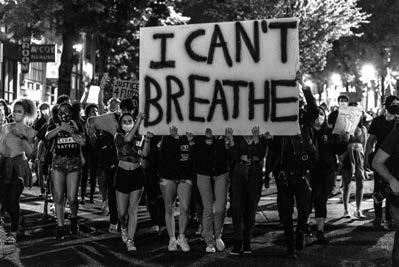
3 minute read
Film at the Margins
AMERICAN GENRE FILM ARCHIVE’S RELEASE OF ‘GO DOWN, DEATH!’ SPOTLIGHTS A BLACK CINEMA PIONEER
BY JOE NOLAN, FILM CRITIC
Approximately 500 what were then called “race films” were created in the United States between 1915 and the early 1950s. These movies were made independently outside the Hollywood studio system. Race films featured black casts and targeted black audiences, and mainstream historians subsequently overlooked them before the BET Network revived interest in these movies in the 1980s.
Only about 100 black movies from this period are still available today, and one of the most stylized and ambitious films of the period is Go Down, Death! (1944).
The American Genre Film Archive has teamed-up with Something Strange to digitize their S-VHS collection of weird, bizarre and hard-to-find treasures including Go Down, Death!, which has just been made available for download. The movie costs 99 cents or pay-what-you-can and all proceeds will be donated to Movement for Black Lives, which seeks to mobilize political power locally and nationally to end police violence against black people among other goals.
Go Down, Death! is directed by Spencer Williams who also stars in the film as its main heavy, Big Jim Bottoms. Williams is best known for portraying Andy in TV’s Amos ‘n’ Andy. The television show had a mixed reception: the NAACP campaigned against the series and its buffoonish characterizations of black stereotypes. However comedians like Redd Foxx praised the show as a pioneering program that put black performers in lead roles.
Regardless of what Williams thought of the show and his character he had much bigger ambitions: Go Down, Death! Is actually the third film in a cinematic religious trilogy, which started with The Blood of Jesus (1941) and was followed by the now-lost film Brother Martin: Servant of Jesus (1942). Big Jim Bottoms runs a jumping juke joint, which Spencer captures with a full dance floor and lots of slick stepping. But when a new preacher comes to town church attendance goes up, and Big Jim’s barstools sit empty. Bottoms and his henchmen plot to blackmail the dashing young preacher with a honey trap scheme, but when Big Jim’s adoptive mother, Aunt Caroline finds out about Jim’s plan a tragedy unfolds.
Go Down, Death! runs just under an hour and much of it is slow viewing. This is a shoestring production and it shows: The locations are limited, the shots and edits are basic, the plot is bare bones simple, and the dialog and performances by many amateur actors are often awkward and stilted. All of this is expected from a movie that was made not only at the margins of the movie industry, but at the margins of society at large.
The movies of this period constitute something very near to outsider art, but like the best work made in the do-it-yourself spirit, Go Down, Death! transcends the limits of its own production in the last five minutes of the film. When Aunt Caroline prays to a portrait of her late husband, asking him to send her prayers to Jesus, the portrait comes to life in the form of a ghost that leads her to the solution to saving the preacher’s reputation. Williams’ double exposure special effect comes out of nowhere, and it’s a delightful cinematic surprise. Later in the film Aunt Caroline and Big Jim each see visions of the Heaven’s pearly gates and the gates of Hell, respectively. Both of the hallucinations are extravagant, otherworldly montages that astound in the context of such an otherwise straightforward film. Williams lifted the footage for his Hell sequence right out of L’enfer — a 1911 Italian silent film adaptation of Dante’s Inferno. It’s an audaciously experimental stylistic leap, and one that seems positively postmodern to 21st century eyes.
Go Down, Death! is available to download for 99 cents or pay-what-you-can from the American Genre Film Archive. Go to https:// agfaamericangenrefilmarchive.vhx.tv/ to get the film and support Movement for Black Lives




